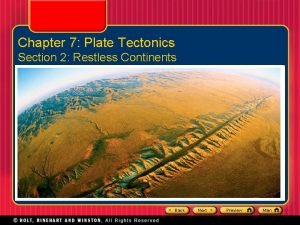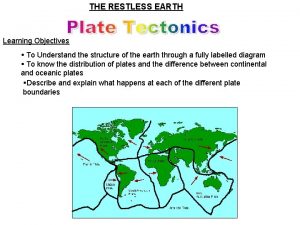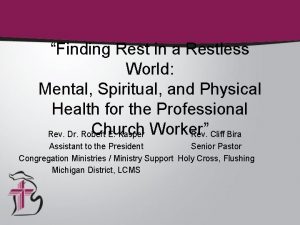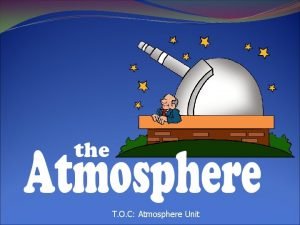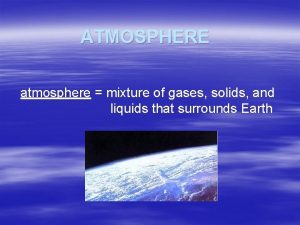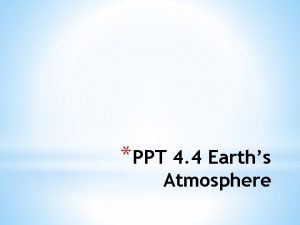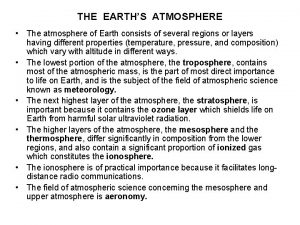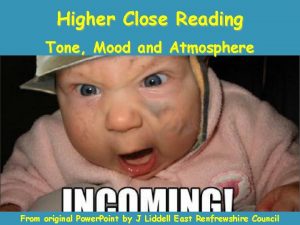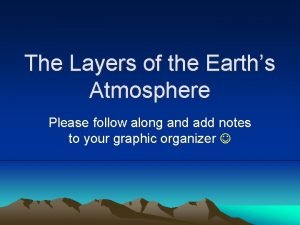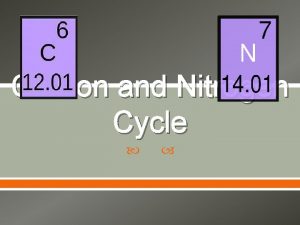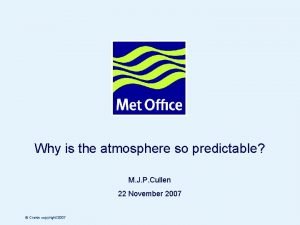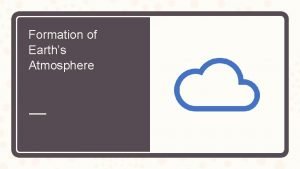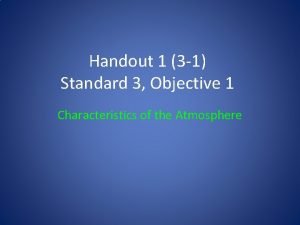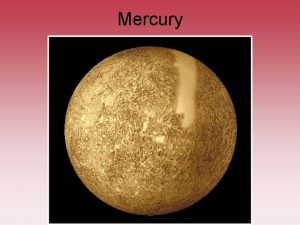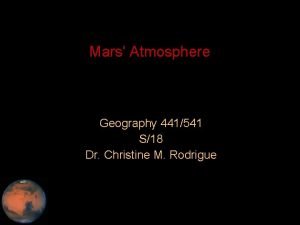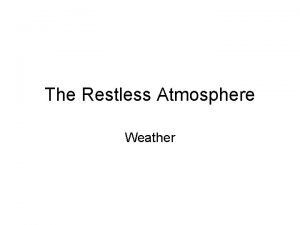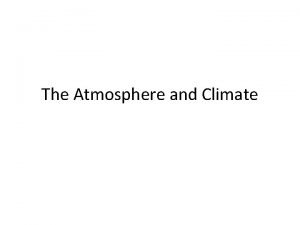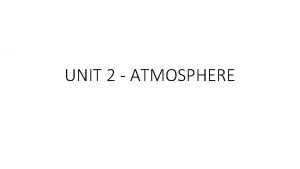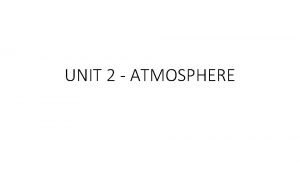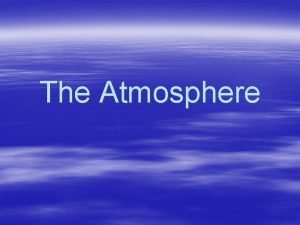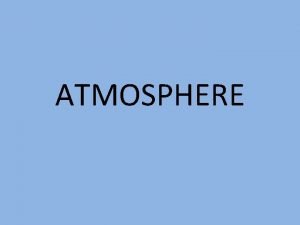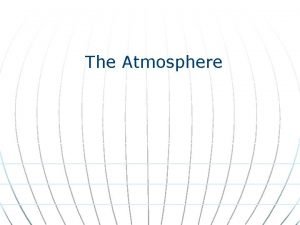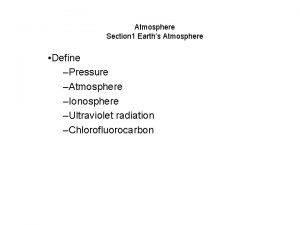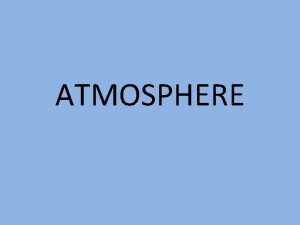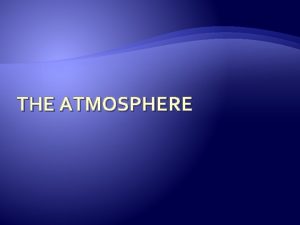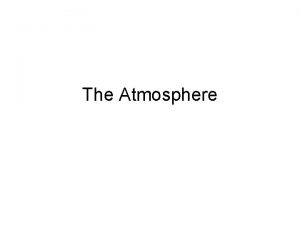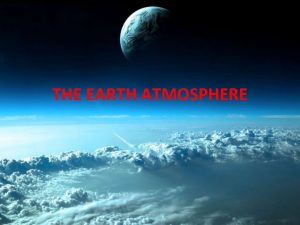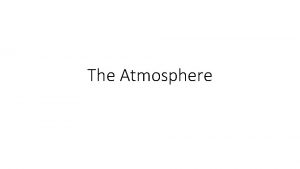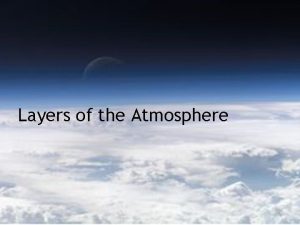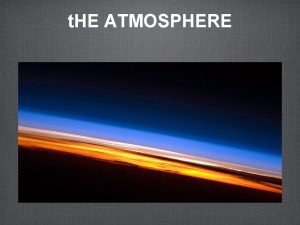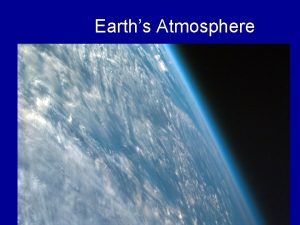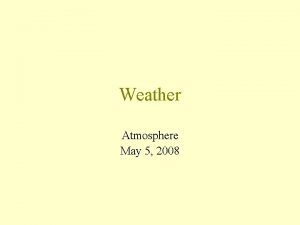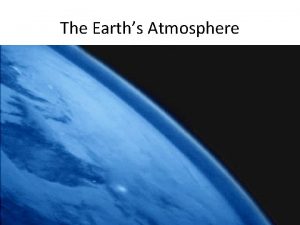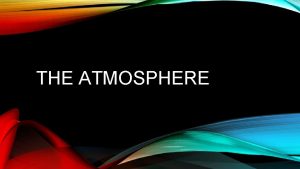THE RESTLESS ATMOSPHERE The Atmosphere The atmosphere is
































































- Slides: 64

THE RESTLESS ATMOSPHERE

The Atmosphere The atmosphere is a blanket of gases surrounding the earth. It is made up of a mixture of different gases: Nitrogen – 78% Oxygen – 21% Others – 1% It is important because it provides us with the air we breathe, absorbs heat from the sun by day, retains heat at night and protects us from harmful rays from the sun.

The Atmosphere

Troposphere The troposphere is the bottom layer of the atmosphere. 12 km thick, 75% of the earth’s gasses are found in this layer.

The Heat Machine The sun is a huge mass of burning gases that give off s 0 lar energy. 50% of the sun’s energy reaches planet earth. 25% is deflected back into space by dust and clouds in the atmosphere. 25% is absorbed as it passes

The Heat Machine

Uneven Heating of Earth The surface of Earth is unevenly heated by the incoming solar energy. The amount received at any place on Earth’s surface depends on the latitude of that place and tilt of Earth’s axis. At the poles, less heat gets through. At the equator, the sun shines directly overhead. At the poles, the sun’s energy is slanted.

Winds and Air Pressure: Atmosphere On the Move The troposphere is always in motion. This moving air is called wind. Winds form because the sun heats different parts of Earth unequally. When air is heated, it expands and becomes lighter. It rises and creates an area of low atmospheric pressure. When air is cooled, it becomes heavier and descends. It presses down on Earth’s surface and creates an area of high atmospheric pressure. Air moves from high pressure areas to low

Seasons and the Sun Earth orbits the sun once every 365¼ days. During this orbit, different parts of earth are tilted towards the sun at different times of the year. These parts receive more direct sunlight than those that are tiled away from the sun. In the Summer in the northern hemisphere: The sun is tilted towards it. Days are long while nights are short. It receives much more solar energy, so its weather is warmer. In the Winter in the northern hemisphere: The sun tilted away from it. Days are short while nights are long. It receives much less solar energy, so its weather is colder.

Winds and Air Pressure: Atmosphere On the Move

Types of Winds are named after the direction from which they blow. The wind that is most frequent in an area is called the prevailing wind. Winds that blow from the equator towards the poles are warm winds. Winds that blow from the poles towards the equator are cold winds.

Global Wind Patterns

Ireland’s Synoptic Stations’ Prevailing Winds

Coriolis Effect The coriolis effect is the earth spinning on its axis. This is because of the winds being deflected at an angle. They are deflected to the right in the northern hemisphere and the left in the southern hemisphere. Doldrums areas close to the equator where the wind speeds are very low or where they have died out entirely. Trade winds were named as a result of their

Coriolis Effect

Ocean Currents The heating of the oceans is very unequal due to different latitudes. Therefore, there are different ocean currents.

Ocean Currents

Air Masses and Weather Systems Air masses are large bodies of air that have similar temperature, pressure and moisture throughout. There are 4 types of air masses on Earth and they are: Maritime air masses which tend to bring rain. Continental air masses which tend to be dry. Polar air masses which bring cold air. Tropical air masses which bring warm air.

Air Masses

Fronts A front is a boundary area where two different air masses meet.

Cold Front A cold front occurs when a cold air mass pushes in and replaces a warm air mass. Warm air mass is lighter so it is forced to rise rapidly into the atmosphere. As the warm air rises, it cools and condensation takes place. Masses of cloud develop. Heavy rain falls along the front.

Cold Front

Warm Front A warm front occurs when a warm air mass approaches a cold air mass. The warm air is lighter so it rises up over the cold air. As the warm air rises, it cools and condenses to form dark, rain-bearing clouds. Continuous rain soon follows. Thunderstorms are normally associated with these, especially in the Summer.

Warm Front

Stationary Front A stationary front forms when a cold front or warm front stops moving. This happens when two masses of air are pushing against each other but neither is powerful enough to move the other. Winds blowing parallel to the front instead of perpendicular can help it stay in place. It normally is associated with heavy rain and temperatures in the low-mid teens whether it is a Winter or Summer month.

Stationary Front

Occluded Front At an occluded front, the cold air mass from the cold front meets the cool air that was ahead of the warm front. The warm air rises as these air masses come together. Occluded fronts usually form around areas of low atmospheric pressure

Occluded Front

Depressions A depression is an area of low pressure and is associated with unsettle weather, including rain, cloud and wind. In the case of Atlantic depressions, warm, moist tropical air from the south meets colder, drier polar air from the north. Due to these differences, the air masses do not mix easily. The warm air is lighter and is forced to rise, creating an area of low pressure at ground level. At the same time, the air begins to move in an anticlockwise direction in the north hemisphere. The cold front begins to wrap itself around the back of the warm air. The warm air is now trapped in a warm sector. The cold front travels faster than the warm front and gradually begins to catch up with it. Eventually, it lifts the warm air completely off the ground. The ground air now consists entirely of cold air and the depression is over. Ireland’s weather is dominated by Atlantic depressions that pass over the country for much of the year. They are also known as cyclones.

Depressions

Anticyclones An anticyclone is an air mass with high pressure at the centre. In the Summer, they bring hot, sunny weather. In the Winter, they bring cold, sunny weather.

Anticyclones

The Water Cycle

Clouds Type of Cloud Appearance Location Fact Weather Cirrus Wispy like a lock of hair High altitude Made of ice crystals Fair, dry and sunny Cumulus Fluffy or woolly and pitch black Medium altitude Known as fair weather clouds Thunderstorms, heavy rain Stratus Puffy and grey Low altitude If they reach Drizzle, light ground level, rain they are called fog

Precipitation: Types When cloud particles become too heavy to remain suspended in the air, they fall to the earth as precipitation. Precipitation can be anything falling from the clouds, including rain, snow, hail and sleet. Rainfall is the most common form and there are three types: Relief rainfall Cyclonic (frontal) rainfall Convectional rainfall

Relief Rainfall A warm wind evaporates water from the sea and blows it to the land. The air is forced to rise when it reaches high ground. As it rises, it cools. Condensation forms cloud because the cooled air can’t hold as much moisture. The droplets then join and get heavier. Rain then falls on the windward slope. On the leeward slope, the air descends and gets warmer. The cloud evaporates so there is very little rain.

Relief Rainfall

Cyclonic (Frontal) Rainfall A warm wind blows towards the cold air. When the warm air reaches the cold air, it rises because it is lighter. As it rises, it cools. Condensation takes place and clouds form (stratus clouds) because the cold air cannot hold as much moisture. The droplets join and get heavier, so rain falls.

Cyclonic (Frontal) Rainfall

Convectional Rainfall The sun heats the ground all morning. The air near the ground gets warm and moisture is evaporated. By early afternoon, the heated air expands, it becomes lighter and rises. The rising air then cools. Condensation takes place and clouds form (cumulus clouds). The cool air is unable to hold all moisture. The droplets then join together and gets heavier and rain falls.

Convectional Rainfall

Weather Weather is the word used to describe the state of the atmosphere at any particular time and place. The study of weather is called meteorology. Meteorologists prepare weather forecasts. Ireland is a country of many different types of weather but rainfall is very common and it rains for more than half the year in Ireland. Met Éireann of Glasnevin is the headquarters of weather forecasting in Ireland. The thermometers and barograph is placed inside a Stevenson screen.

Importance of Weather Forecasts The upcoming weather will influence what we wear and the activities that we undertake. It may affect our mood. Some occupations require very accurate weather forecasts such as farming, fishing, tourism, air traffic and sport.

Weather Element Instrument Unit of Measurement Isoline Maps Temperature Dry bulb thermometer °C/Degrees Celsius °F/Degrees Fahrenheit Isotherms Maximum thermometer Minimum thermometer Humidity Hygrometer Percentages (%) Precipitation Rain gauge Millimetres (mm) Isohyets Sunshine Campbell-Stokes recorder Hours (hrs) Isohels Wind Speed Anemometer (Beaufort scale) Km/hr or mph or knots Isotachs Wind Direction Wind vane Directions Air Pressure Aneroid barometer Millibars (mb)/Hectopascals (h. Pa) Isobars

Temperature Temperature tells us how hot or cold it is in an area. It is measured in ºC/ºF. It is measured using a thermometer. Celsius is also known as centigrade. The liquid in a thermometer is known as mercury. Isotherms are lines on a weather map that join places of equal temperature. Mean temperature = Sum of temperatures ÷ number of months/days Temperature range = Maximum temperature − Minimum temperature

Thermometer

Humidity is the amount of water vapour in the air. It is measured in %. It is measured with a hygrometer. The difference in temperature between the two thermometers is used to find the relative humidity. The greater the difference between the temperatures, the lower the relative humidity.

Hygrometer

Precipitation Precipitation is any form of moisture falling from clouds. Mainly in the form of rain, snow and hail. Rainfall is measured in millimetres (mm). Snowfall is measured in centimetres or inches (cm/ins). It is measured using a rain gauge. Isohyets are lines on a weather map that join places of equal precipitation.

Rain Gauge

Sunshine Sunshine is the shining of the sun. It is measured in hours (hrs). It is measured by a Campbell-stokes sunshine recorder. Isohels are lines on a weather map that join places with equal amounts of sunshine. The glass sphere concentrates the rays of the sun onto a spot on strip of paper. The paper is marked off in hourly intervals. If the sun is shining, it burns a mark on the paper. If the sun does not shine, the paper is unmarked. As the sun moves across the sky, its rays concentrate on a different section of paper.

Campbell-Stokes Sunshine Recorder

Wind Speed The wind speed tells us how strong the wind is. It is measured using an anemometer. It is measured in either km/hr or mph. Isotachs are lines on a weather map that join places with equal

Anemometer

Wind Direction The direction of the wind is indicated by a weather vane. Wind direction is described by the direction from which the

Wind Vane

Air Pressure The air pressure tells us the weather we expect in a region. The lower it is from 1000 h. Pa, the wetter or stormier it is. The higher it is from 1000 h. Pa, the drier or sunnier it is. It is measured using a barometer or aneroid barometer. A barograph connects a barometer to a chart to record the air pressure. It is measured in either hectopascals (h. Pa) or millibars (mb). Isobars are lines on a weather map that join

Barometer

El Niño El Niño is a weather pattern that leads to different weather conditions around the world with most affects on the Pacific Ocean. It happens every 2 -7 years. The Pacific waters warm up by at least 1 degree above normal. Fewer Atlantic hurricanes take place but areas around the Gulf of Mexico are still expected to be wetter than normal. Drier than normal conditions are expected in the Ohio Valley region as well as the northwest of the USA. It gives away to wetter than normal conditions in South America. The monsoon season in Asia is weaker than normal. More active typhoons take place in the Pacific Ocean due to the warm waters. Some evidence show it gives very cold Winters to north, east and west Europe.

The Greenhouse Effect and Global Warming The greenhouse effect is when gases of the atmosphere trap much energy into it and they act like the glass on a greenhouse because they let heat in and prevent most of it getting out. Carbon dioxide, methane, chlorofluorocarbons (CFCs) and nitrous oxide are the most effective gases at trapping heat. Due to the atmosphere trapping gases like a greenhouse, global warming takes place. Earth is over 6 x warmer than it was in 1900.

Causes of Global Warming Cause Description Burning of fossil fuels Burning fossil fuels in homes, factories and power stations raises the level of carbon dioxide in the atmosphere. Deforestation Trees absorb carbon dioxide and give off oxygen in its place. As more forests are cut down, there are fewer trees to perform this function. Methane Cattle produce methane as they digest their food. Methane is also released into the atmosphere from decaying organic matter in landfill sites. Burning of fuels The use of nitrates as a fertiliser also adds to the increase of the gas in the atmosphere. CFCs The use of cfs in fridges, aerosols and foams has been reduced because they damage the ozone layer. They are the most damaging greenhouse gas.

Impacts of Global Warming on the World Impact Description A rise in sea levels As global temperatures increase, the polar ice caps will melt. Sea temperatures will increase and the water in them will expand. Overall, sea levels will rise by up to 60 cm over the next century. Climate change Tropical storms and hurricanes will become more frequent and stronger. The hurricane season may also become longer. Rainfall patterns will change and weather forecasting will become unpredictable.

Impacts of Global Warming on Ireland 1. Ireland's soft rains will become strong downpours in the north and west and will lead to increased flooding & bogbursts. 2. Summers in the south and the interior will become warmer and drier. This may lead to water shortages. It will also lead to a change in agriculture as crops replace grass. This will impact on livestock farming. 3. If the North Atlantic Drift slows down, it will have less of a warming effect on our shores. 4. Low lying areas will be open to flooding from both rising sea levels and increased storm strength and frequency. Soft coastlines will be open to erosion. Land will be lost as sea defences are too expensive. 5. While drier summers will have a negative impact on growing crops such as potatoes, Mediterranean crops may be grown instead. 6. Storm activity will become more frequent and more severe.

Solutions to Global Warming Solution Description Clean energy Reduce dependence on fossil fuels. Use cleaner and renewable energy sources such as solar, wind, wave and hydropower. Reduce deforestation This should be accompanied by reafforestation (replanting trees), especially in tropical regions. Reduce, reuse and recycle Reduce the need for manufactured goods and their transport over long distances. Use energy-efficient appliances These include lights, fridges and heaters.
 Restless leg synd
Restless leg synd Chapter 7 section 2 restless continents answer key
Chapter 7 section 2 restless continents answer key Nicole rime
Nicole rime The crust of the earth is unstable and restless
The crust of the earth is unstable and restless Restless leg syndrome nz
Restless leg syndrome nz Restful vs restless
Restful vs restless Quá trình desamine hóa có thể tạo ra
Quá trình desamine hóa có thể tạo ra Công thức tiính động năng
Công thức tiính động năng Tư thế worm breton
Tư thế worm breton Thế nào là mạng điện lắp đặt kiểu nổi
Thế nào là mạng điện lắp đặt kiểu nổi Khi nào hổ con có thể sống độc lập
Khi nào hổ con có thể sống độc lập Các loại đột biến cấu trúc nhiễm sắc thể
Các loại đột biến cấu trúc nhiễm sắc thể Thế nào là sự mỏi cơ
Thế nào là sự mỏi cơ Vẽ hình chiếu đứng bằng cạnh của vật thể
Vẽ hình chiếu đứng bằng cạnh của vật thể độ dài liên kết
độ dài liên kết Bổ thể
Bổ thể Thiếu nhi thế giới liên hoan
Thiếu nhi thế giới liên hoan điện thế nghỉ
điện thế nghỉ Một số thể thơ truyền thống
Một số thể thơ truyền thống Trời xanh đây là của chúng ta thể thơ
Trời xanh đây là của chúng ta thể thơ Hát lên người ơi
Hát lên người ơi Số.nguyên tố
Số.nguyên tố Phối cảnh
Phối cảnh đặc điểm cơ thể của người tối cổ
đặc điểm cơ thể của người tối cổ Các châu lục và đại dương trên thế giới
Các châu lục và đại dương trên thế giới Tỉ lệ cơ thể trẻ em
Tỉ lệ cơ thể trẻ em Sơ đồ cơ thể người
Sơ đồ cơ thể người ưu thế lai là gì
ưu thế lai là gì Tư thế ngồi viết
Tư thế ngồi viết Cái miệng nó xinh thế
Cái miệng nó xinh thế Các môn thể thao bắt đầu bằng tiếng nhảy
Các môn thể thao bắt đầu bằng tiếng nhảy Mật thư tọa độ 5x5
Mật thư tọa độ 5x5 Hát kết hợp bộ gõ cơ thể
Hát kết hợp bộ gõ cơ thể Tư thế ngồi viết
Tư thế ngồi viết Thẻ vin
Thẻ vin Thế nào là giọng cùng tên? *
Thế nào là giọng cùng tên? * Thể thơ truyền thống
Thể thơ truyền thống Gấu đi như thế nào
Gấu đi như thế nào Các châu lục và đại dương trên thế giới
Các châu lục và đại dương trên thế giới Từ ngữ thể hiện lòng nhân hậu
Từ ngữ thể hiện lòng nhân hậu Hổ sinh sản vào mùa nào
Hổ sinh sản vào mùa nào Diễn thế sinh thái là
Diễn thế sinh thái là Vẽ hình chiếu vuông góc của vật thể sau
Vẽ hình chiếu vuông góc của vật thể sau Thế nào là hệ số cao nhất
Thế nào là hệ số cao nhất Làm thế nào để 102-1=99
Làm thế nào để 102-1=99 Lp html
Lp html Lời thề hippocrates
Lời thề hippocrates đại từ thay thế
đại từ thay thế The ozone layer protects us from
The ozone layer protects us from Solids in the atmosphere
Solids in the atmosphere Earth atmosphere ppt
Earth atmosphere ppt Earth’s atmosphere
Earth’s atmosphere Tone mood atmosphere
Tone mood atmosphere Facts about gatsby in chapter 3
Facts about gatsby in chapter 3 Classroom atmosphere
Classroom atmosphere Extends high earth atmosphere
Extends high earth atmosphere The veldt symbolism
The veldt symbolism Academic atmosphere definition
Academic atmosphere definition Elements of acting
Elements of acting Carbon moves from the atmosphere to plants
Carbon moves from the atmosphere to plants Atmosphere definition
Atmosphere definition Primordial atmosphere
Primordial atmosphere What is atmosphere
What is atmosphere What is mercurys atomic mass
What is mercurys atomic mass Mars atmosphere
Mars atmosphere

